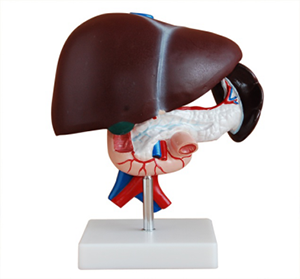26-02-2025
ADA MED SUPPLY LIMITED
Article tag: Hepatopancreatic duodenal model BIX-A1053 organ anatomy model
Advances in medical technology
Hepatopancreatic duodenal model, as a high-precision medical simulation tool, plays an increasingly important role in medical technology education. By simulating the anatomy of the liver, pancreas, and duodenum, students and physicians can practice procedures related to the hepatobiliary and pancreatic systems in a risk-free environment. This model not only accurately reproduces the real organ and tissue structure, but also simulates the complex surgical environment, providing the trainees with the opportunity to perform the operation. These characteristics make the model have significant advantages in surgical skill training, especially in complex operations such as liver resection, pancreas surgery and biliary tract surgery, which can improve the operational accuracy and coping ability of students.

Hepatopancreatic duodenal model
Industry expert views
Industry experts generally agree that the use of the hepatopancreatic duodenal model is essential for the surgical skills training of surgeons, especially surgical residents and trainees. Experts said that traditional teaching methods often lack enough practical opportunities, and training through simulation models can allow students to accumulate valuable experience in real operating environments. For example, experts point out that simulation training can help participants in liver and pancreas surgery, reduce the damage caused by surgical errors, and improve the speed and accuracy of intraoperative decision making. Therefore, the hepatopancreatic duodenal model provides a low-risk and repeatable platform for medical education, which significantly improves the quality of surgical training.
Education and training significance
Hepatopancreatic duodenal model is of great significance to medical education. In medical teaching, anatomy, surgical operation and clinical decision-making are the basic contents. The hepatopancreatic duodenal model allows students to practice the anatomy and handling of liver, pancreas and other organs in a simulated environment, improve their understanding of anatomical structure, and improve their skills through simulated surgery. Because the simulation model is not limited by cadaver resources, participants can practice repeatedly in a stress-free environment, thereby strengthening muscle memory and improving clinical coping skills.
Data support
Studies have shown that hepatopancreatic duodenal model has a significant effect on improving surgical skills. According to a study of 100 surgical residents, those trained on the hepatopancreatic duodenal model showed significant improvements in both operational accuracy and surgical efficiency. Of these participants, more than 80% said that through the model training, in the actual surgery to reduce the liver, pancreas and duodenum injury and wrong removal. The data also showed that physicians who received simulation training had a 25% lower rate of postoperative complications than those who did not receive training, further demonstrating the importance of the hepatopancreatic duodenal model for improving surgical skills.
Conclusion
The application of hepatopancreatic duodenal model in the training of surgical skills has significantly improved the students' understanding and operation accuracy of complex surgical operations. Through high-precision simulation training, students can not only improve the mastery of anatomical knowledge, but also better cope with various challenges in clinical practice and reduce surgical errors. With the continuous development of medical technology, hepatopancreatic duodenal models will continue to be an important tool for surgical skills training to support the improvement of medical service quality and patient safety.